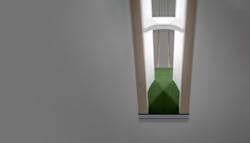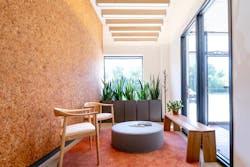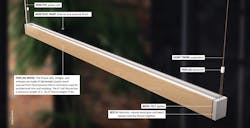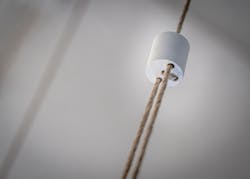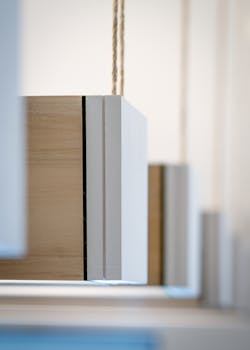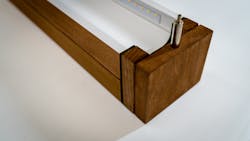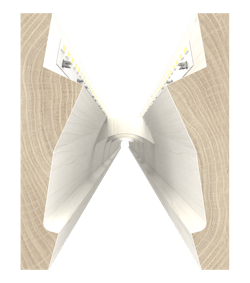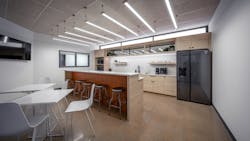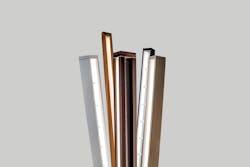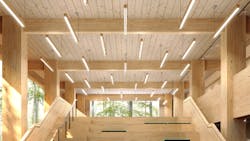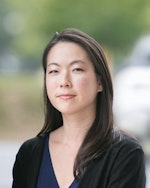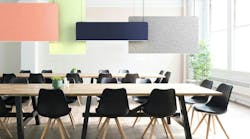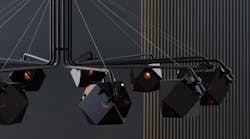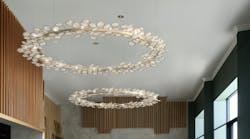Just two years old, Philadelphia-based lighting manufacturer Lightly has already made history with Butterfly, the world’s first commercial LED luminaire with a fixture housing that is free of metal, plastic, and glass, according to the company. Instead, the linear, direct-indirect fixture is made primarily of lightweight wood, wool, and hemp. It is 95% biodegradable and 3% recyclable. It also qualifies for the Buy American Act: 95% of the product's components by weight and more than 65% of its components by value are sourced domestically. Finally, the product is compliant with the International Living Future Institute’s Red List.
At the time of publication, Lightly was about nine months into shipping out product—and planning to grow its workforce to meet demand. Benjamin Rapkin, general manager of Lightly and partner company Lightglass, shares with Architectural SSL when he realized an all-natural, biodegradable product line would be his company's legacy in the lighting industry.
ArchSSL: What motivated your company to create a low-embodied carbon lighting solution?
Rapkin: Our CEO, Sean Darras, and our company have always been on a mission to create lighting solutions that benefit people. When he started [sister company] Luxtech almost 11 years ago, it was about reducing operational carbon. With [sister company] Lightglass, it was about delivering the best quality of light to help people with their sleep and their circadian rhythm, and to [emulate] daylight inside windowless spaces, which benefits people psychologically.
Around 2.5 years ago, an architecture firm basically showed me this list of six items and said, “If your products don’t meet at least one of these six items, we’re not specifying it. It’s going to get buried in our library and no one’s going to use it.” And each of the six criteria were about sustainability: Do you have sustainability documentation? Do you use natural materials? Do you have end-of-life options?
We were not prepared for that type of filtering of products. I came back to the engineering team and had an all-company, all-hands meeting. I gave a short presentation about sustainability and these six criteria and said, “If we don’t invest in sustainability now, we shouldn’t expect to be around in 10 years as a company.” That was a bold claim for me to make, but it stuck.
Then the engineering and R&D team started looking further and saw how sustainability likely will not always be a choice. Now it’s a choice, and sometimes you even have to pay a premium for it. But we are starting to see places like Vancouver passing bylaws that require carbon reporting and carbon limits on new residential and commercial construction. And the lighting industry is woefully unprepared for this.
Every single other lighting product in all of the world right now has plastic and metal in it. We’re trying to show the industry that it’s unnecessary for most lighting to have those materials, and that those materials should only be reserved where they’re absolutely needed.
What applications do you anticipate for Lightly’s products, Butterfly and Glow?
We spent over a year in product development and then started working with friends in the design industry to see how they would use it. One of its first uses was in commercial offices: a bank office in Puerto Rico and then a large project in Boston, with another one on the way.
As the brand matures, I expect a lot of government work. The federal government has aggressive carbon goals for 2030, and it’s treated lighting as an exception up until this point. Now, it doesn’t need to. We hope that it’ll be one of our biggest customers.
Education is a big market. [Schools and universities] are building like crazy, and keeping toxins out of the classroom and hitting carbon targets at the local level are important to people.
We originally thought [the health care market] was not going to work well for Lightly because its products are made from organic material, but a local hospital representative recently said they would be fine in certain spaces, such as waiting rooms.
I understand you worked with lighting consultant Brad Koerner on product development.
Yes, Brad came in about a year into our journey and inspired us with a concept he created for a bamboo linear pendant. He had that concept before he met with us, and we had a lot of work going before we met with him. But when we connected, it flipped the switch in our engineering team’s mind and they gained clarity about how to move forward. We didn’t end up using bamboo, but we took the best of what Brad had created and the best of what we had learned about materials and came out with the Butterfly pendant, our flagship product.
I believe that the Butterfly has its own place in the timeline of historic lighting because it’s the first LED light fixture that has no plastic or diffusion material, but it still creates the same distribution of light at the same or at better cost.
From the process of designing the Butterfly, we learned that the business model is better when you look at sustainable materials as opposed to traditional metals and plastics. The supply chain is closer to home. You use less energy to transport materials. The materials are easier to shape. They last long, have better end-of-life options, and they handle humidity well.
You source about much of your materials domestically. How did you develop your supply chain?
This is one of the most interesting parts of this story, because the supply chain for lighting is well established in aluminum extrusion, steel hardware, plastic diffusion, and LED modules and drivers that come from East Asia. And that’s how everyone has done it.
If you are measuring by weight, 95% of our product's weight is made from components sourced domestically. If you are measuring by dollar value, more than 65% of the value of the components of our products are sourced domestically.
Our supply chain needed to be created from the ground up, but we didn’t want to reinvent everything. For example, we’re using poplar wood from Pennsylvania. The butterfly product is actually made from a common architectural form: wood moldings, similar to what would be made for a baseboard or a crown molding.
We’re using architectural products meant for other architectural solutions. This supply chain is well developed. It just hasn’t been used for lighting before. We are a small part of this massive supply chain, which means we can scale rapidly and still service our customers on time because we’re not creating the supply chain ourselves.
The expected operating life of Lightly product is 10-plus years. I have always wondered why products comprise materials that essentially last forever when they will likely be switched out in about 10 years.
Lighting is like fashion. Manufacturers are making incremental changes to their products every few months, and everyone wants the newest thing, regardless of the fact that they installed new lighting three years ago in the same space.
Lighting is a design product so it makes sense. We just need to make our products out of materials that can return to Mother Nature or have better options at the end-of-life. We’re not trying to stop people from innovating, choosing new products, or creating new trends. We just want those trends to have great end-of-life options.
From the highest level, we’ve created our product out of primarily biodegradable materials so we currently have a lot of options at the end of life. You could remove the LED strip, put a new strip in the housing, and keep using it. You can remove the LED strip and compost the housing. You could send the housing back to us, and we can turn it into something else. What’s most likely to happen is the status quo: It will end up in a landfill, but at least it will biodegrade in a landfill.
We’re in the process of creating a program for what happens at a fixture end of life. Luckily, we have some time because we just launched a few months ago.
What are common barriers for customers?
There are a lot of obstacles that come up, but we’re easily able to get past them. Some people say, “I don’t want be the first to use something made of wood.” We remind them that the materials that make up the Lightly product are all over your building already. We’re just using them in a new way.
Another obstacle is people’s perception of electronics and fire occurring in the product. We have remote drivers so all the energy entering our product is Class 2 low voltage power, which has a very low risk of sparking. We’ve [researched] how mass timber buildings handle fire versus traditional concrete and steel. [A wood fixture would] char and fall as ash. In a traditional metal fixture, the diffuser would melt and turn into a hot liquid falling from the ceiling, which is dangerous.
The other obstacle is that people are used to having a lot of distribution options from one shape, one profile, one fixture. Since we’re not using any plastic or diffusers, the [light] distribution is created by the internal shape—the profile—of the fixture itself. Our Butterfly fixture has the internal shape of a butterfly, and it creates a butterfly batwing distribution.
People want cove lighting, recessed, and wall grazing. All of that is coming. We’re going to make sustainable versions of every type of linear lighting solution and then move into other architectural categories. We launched with surface mount and suspended versions of the product, and the rest of the solutions are coming.
That’s the biggest request right now. People want sustainable alternatives to everything they are used to using in aluminum and plastic, and we’re designing them as quickly as we can.
What’s the cost differential of Lightly product?
When designers ask us about price, they word it as, “How much of a premium is this?” We priced Lightly fixtures to not have a premium. It’s priced at the high end of mid-tier linear or the low end of high-end linear. And this is our first full year of production and shipping, so the economics will only get better as we grow and as demand grows for these products.
[Customers will get] all the same performance, same cost, same lead times, better aesthetics, and a better sustainability story at the same price. We’re trying to make it an easy choice to choose Lightly not only as a decorative fixture or for sustainable projects only, but as your Type A standard linear for everything.
We’re trying to accelerate the whole industry to sustainable design. We want you to use it on everything because it’s the right thing to do. When another sustainable lighting company comes out, we’ll want you to use them instead of traditional lighting as well. The more projects we can earn, the more pressure we’re going to put on the other manufacturers to change.
Have you heard from big lighting companies that are interested in collaborating? Or are you worried about competition from other companies that want to emulate this model?
No. Frankly, we want other manufacturers to invest in this. At our LEDucation booth, we showed an exploded view of our flagship product. We had just as many manufacturers come by our booth as anyone else, and we want them to see how this is better to do things this way and have them change.
At this point, it’s a disadvantage being the only sustainable product in the market because we’re the only ones developing and growing the supply chain. We’re the only ones educating the design community on what is sustainability, how do you measure it, what’s the documentation.
We need as many stakeholders in our industry all pushing this boulder up the same hill at the same time to make this change. Lightly is a catalyst to put on the pressure to create change in the industry. I truly hope we are not the only ones thinking like this two years from now.
It is going to be a harder transition for larger lighting manufacturers to go in a new direction. We have a lot of agility in our small team—about 30 people across our three brands—and we’re all leaders.
A big $100 million linear manufacturer that’s working exclusively in aluminum, steel, and plastic is going to have a hard challenge not only in publishing all the sustainability documentation, but in changing their supply chains and manufacturing tooling and facilities, and in retraining their teams. This is not an easy thing to do.
That’s why if we don’t apply enough pressure, and if we don’t get enough support from the design community, [greater sustainability in lighting products] is not going to happen. We launched Lightly is to raise the bar, to show everyone, “Look at what’s possible from a little company in Pennsylvania. And this is what you should expect in sustainable design.”
This interview has been edited and condensed for clarity. An excerpt of this story appeared in the Spring/Summer 2023 issue of Architectural SSL.
For more architectural lighting projects, products and news from LightSPEC (formerly Architectural SSL), subscribe to our newsletters and follow us on LinkedIn, Instagram, X and Facebook.
